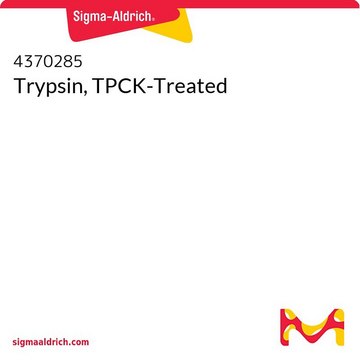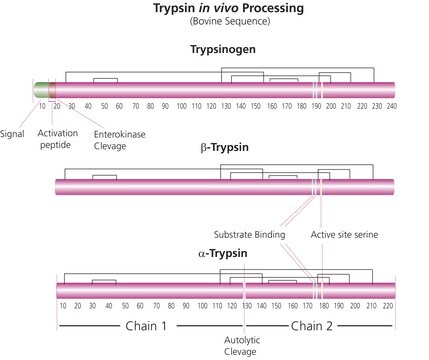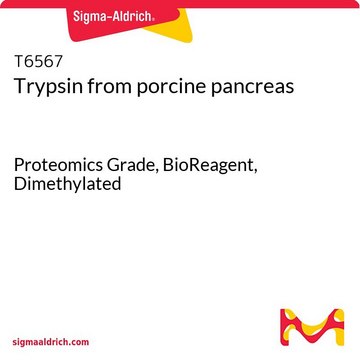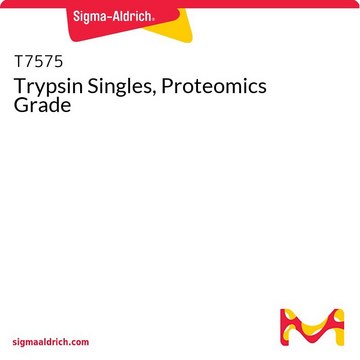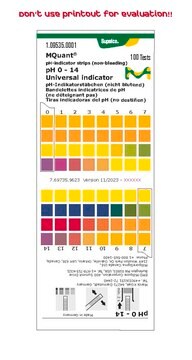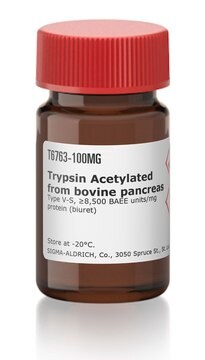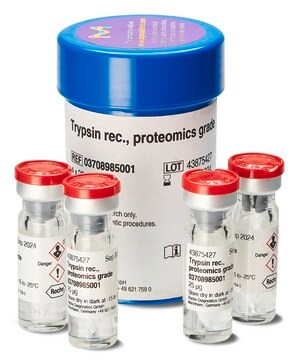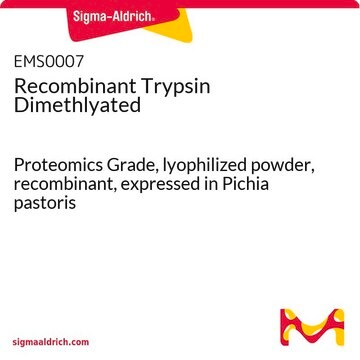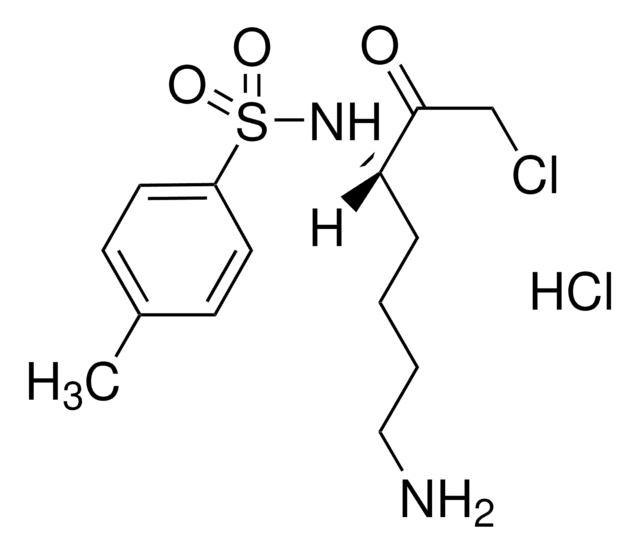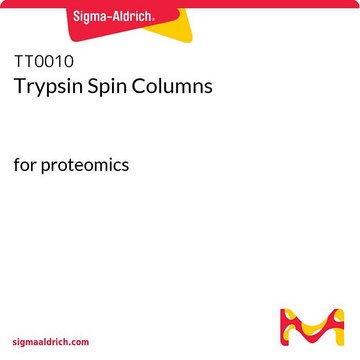4352157
Trypsin, TPCK-Treated
Synonym(e):
6- (1-tosylamido-2-phenyl) ethyl chloromethyl ketone treated Trypsin, Modified trypsin (TPCK-Treated), Trypsin, TPCK treated
Anmeldenzur Ansicht organisationsspezifischer und vertraglich vereinbarter Preise
Alle Fotos(1)
About This Item
UNSPSC-Code:
12352204
NACRES:
NA.56
Empfohlene Produkte
Versandbedingung
dry ice
Lagertemp.
−20°C
Allgemeine Beschreibung
Trypsin is a serine protease that specifically hydrolyzes peptide bonds at the carboxyl side of Lysine and Arginine residues. This modified trypsin has been treated with N-tosyl-L-phenylalanine chloromethyl ketone (TPCK) to inactivate extraneous chymotryptic activity. This trypsin product also contains calcium chloride, which may improve consistency in digestion. Each package contains 10 vials, with 25 μg in each vial.
Anwendung
Trypsin, TPCK-Treated has been used for the digestion of protein samples to generate peptides for LC-MS (liquid chromatography–mass spectrometry)/MS analysis.
Trypsin, TPCK-Treated has been used in enzymatic treatment to cleave the recombinant native B-cell lymphoma-extra large (Bcl-xL)-ΔTM monomer to generate fibrils (the third type of Bcl-xL fibril, called “BclxLcf37”). It has also been used in influenza infection experiments as a supplement in infection/DMEM serum-free medium to infect A549 cells with influenza A H1N1 virus at a multiplicity of infection (MOI) to perform multi-round infection.
Signalwort
Danger
H-Sätze
Gefahreneinstufungen
Eye Irrit. 2 - Resp. Sens. 1 - Skin Irrit. 2
Lagerklassenschlüssel
10 - Combustible liquids
Flammpunkt (°F)
Not applicable
Flammpunkt (°C)
Not applicable
Hier finden Sie alle aktuellen Versionen:
Analysenzertifikate (COA)
Lot/Batch Number
Leider sind derzeit keine COAs für dieses Produkt online verfügbar.
Wenn Sie Hilfe benötigen, wenden Sie sich bitte an Kundensupport
Besitzen Sie dieses Produkt bereits?
In der Dokumentenbibliothek finden Sie die Dokumentation zu den Produkten, die Sie kürzlich erworben haben.
Kunden haben sich ebenfalls angesehen
Quantitative milk proteomics--host responses to lipopolysaccharide-mediated inflammation of bovine mammary gland.
Danielsen M, et al.
Proteomics, 10, 2240-2249 (2010)
Pavel Bouchal et al.
Cell reports, 28(3), 832-843 (2019-07-18)
Accurate classification of breast tumors is vital for patient management decisions and enables more precise cancer treatment. Here, we present a quantitative proteotyping approach based on sequential windowed acquisition of all theoretical fragment ion spectra (SWATH) mass spectrometry and establish
Irene Pila-Castellanos et al.
PLoS pathogens, 17(2), e1009340-e1009340 (2021-02-18)
Influenza virus infections are major public health threats due to their high rates of morbidity and mortality. Upon influenza virus entry, host cells experience modifications of endomembranes, including those used for virus trafficking and replication. Here we report that influenza
Douglas E Vetter et al.
Methods in molecular biology (Clifton, N.J.), 493, 345-366 (2008-10-08)
Modern biologists have at their disposal a large array of techniques used to assess the existence and relative or absolute quantity of any molecule of interest in a sample. However, implementing most of these procedures can be a daunting task
Haruka Chino et al.
Molecular cell, 74(5), 909-921 (2019-04-23)
Certain proteins and organelles can be selectively degraded by autophagy. Typical substrates and receptors of selective autophagy have LC3-interacting regions (LIRs) that bind to autophagosomal LC3 and GABARAP family proteins. Here, we performed a differential interactome screen using wild-type LC3B
Unser Team von Wissenschaftlern verfügt über Erfahrung in allen Forschungsbereichen einschließlich Life Science, Materialwissenschaften, chemischer Synthese, Chromatographie, Analytik und vielen mehr..
Setzen Sie sich mit dem technischen Dienst in Verbindung.